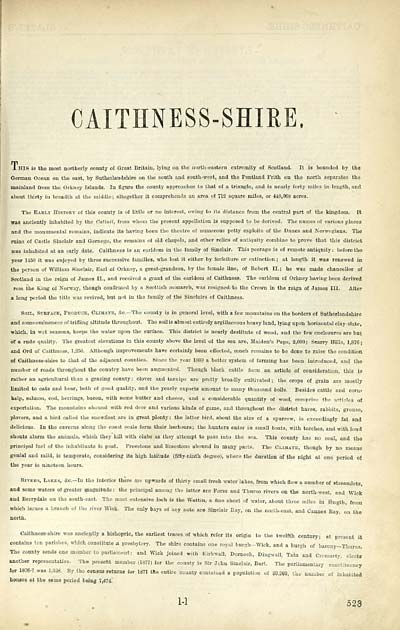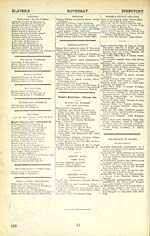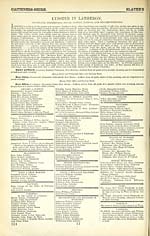Scotland > 1868, 1878 - Slater's (late Pigot & Co.'s) Royal national commercial directory and topography of Scotland > 1878 > Part 1
(601)
Download files
Complete book:
Individual page:
Thumbnail gallery: Grid view | List view

CAITHNESS-SHIRE.
X HIS is the most northerly county ot Great Britain, lying on the north-eastern extremity of Scotland. It is bounded by the
German Ocean on the east, by Sutherlandshire on the south and south-west, and the Pentland Frith on the north separates the
mainLand from the Orkney Islands. In figure the county approaches to that of a triangle, and is nearly forty miles in length, and
about thirty in breadth at the middle; altogether it comprehends an area of 712 square miles, or 448,068 acres.
The Early History of this county is of little or no interest, owing to its distance from the central part of the kingdom. It
was anciently inhabited by the Catinii, from whom the present appellation is supposed to be derived. The names of various places
and tlie monumental remains, indicate its having been the theatre of numerous petty exploits of the Danes and Norwegians. The
ruing of Castle Sinclair and Gernego, the remains of old chapels, and other relics of antiquity combine to prove that this district
was inhabited at an early date. Caithness is an earldom in the family of Sinclair. This peerage is of remote antiquity : before tho
year 1450 it was enjoyed by three successive families, who lost it either by forfeiture or extinction ; at length it was renewed in
the person of William Sinclair, Earl of Orkney, a great-grandson, by the female line, of Robert II.; he was made chancellor of
Scotland in the reign of James II., and received a gi-ant of tho earldom of Caithness. The earldom of Orkney having been derived
rom the liing of Norway, though confli'med by a Scottish monarch, was resigned to the Crown in the reign of James III. After
a long period the title was revived, but u'lt in the family of the Sinclairs of Caithness.
Soil, Suetaoe, Pboddoe, Climate, &c.— The county is in general level, with a few mountains on the borders of Sutherlandshire
and someeminenoes ot trifling altitude throughout. The soUis almost entirely argillaceous heavy land, lying upon horizontal clay-slate,
which, in wet seasons, keeps the water upon the surface. This district is nearly destitute of wood, and the few enclosures are but
of a rude quality. The greatest elevations in this county above the level of the sea are, Maiden's Paps, 2,000 ; Scarry Hills, 1,876 •
and Ord of Caithness, 1,250. Although improvements have certainly been effected, much remains to be done to raise the condition
of Caithness-slme to that of the adjacent counties. Since the year 1809 a better system of farming has been introduced, and the
number of roads throughout the country have been augmented. Though black cattle form an article of consideration, this is
rather an agricultural than a grazing county : clover and turnips are pretty broadly cultivated ; the crops of grain are mostly
limited to oats and bear, both of good quality, and the yearly exports amount to many thousand bolls. Besides cattle and corui
kelp, salmon, cod, herrings, bacon, with some butter and cheese, and a considerable quantity of wool, comprise the artioles of
exportation. The mountains abound with red deer and various kinds of game, and throughout the district hares, rabbits, grouse
plovers, and a bird called the snowfleet are in great plenty: the latter bird, about the size of a sparrow, is exceedingly fat and
delicious. In tho caverns along the coast seals form their harbom-s; the hunters enter in small boats, with torches and with loud
shouts alarm the animals, which they kUl with clubs as they attempt to pass into the sea. This county has no coal and the
principal fuel of the inhabitants is peat. Freestone and limestone abound in many parts. The Cliliate, though by no means
gonial and mild, is temperate, considering its high latitude (flfty-ninth degi'ee), where tho dui-ation of the night at one period oj
the year is nineteen hours.
Rivers, Lakes, &c.— In the interior there are upwards of thirty small fresh water lakes, from which flow a number of streamlets
and some waters of greater magnitude : the principal among the latter are Porss and Thurso rivers on the north-west, and VVict
and Berrydale on the south-east. The most extensive loch is the Wattin, a ane sheet of water, about three miles in length, from
which issues a branch of the river Wick. The only bays of any note are Sinelaii' Bay, on the north-east, and Cannes Bay, on the
north.
Caithness-ahire was anciently a bishopric, the earUest traces of which refer its origin to the twelfth century; at present it
contains ten parishes, which constitute ^ presbytery. The shire contains one royal burgh-Wick, and a burgh of barony-Thurso.
The county sends one member to parliament; and Wick joined with lOrkwaU, Dornoch, DingwaU, Tarn and Cromarty, elects'
another representative. The present member (1877) for the county is Sir John Sinclau-, Bart. The parUamentary constituency
for 1876-7 was 1,323. By the census returns for 1871 the entu-e county contained a population of 39,882, the umuber of inhabited
houses at the same period being 7,474.
1-1 523
X HIS is the most northerly county ot Great Britain, lying on the north-eastern extremity of Scotland. It is bounded by the
German Ocean on the east, by Sutherlandshire on the south and south-west, and the Pentland Frith on the north separates the
mainLand from the Orkney Islands. In figure the county approaches to that of a triangle, and is nearly forty miles in length, and
about thirty in breadth at the middle; altogether it comprehends an area of 712 square miles, or 448,068 acres.
The Early History of this county is of little or no interest, owing to its distance from the central part of the kingdom. It
was anciently inhabited by the Catinii, from whom the present appellation is supposed to be derived. The names of various places
and tlie monumental remains, indicate its having been the theatre of numerous petty exploits of the Danes and Norwegians. The
ruing of Castle Sinclair and Gernego, the remains of old chapels, and other relics of antiquity combine to prove that this district
was inhabited at an early date. Caithness is an earldom in the family of Sinclair. This peerage is of remote antiquity : before tho
year 1450 it was enjoyed by three successive families, who lost it either by forfeiture or extinction ; at length it was renewed in
the person of William Sinclair, Earl of Orkney, a great-grandson, by the female line, of Robert II.; he was made chancellor of
Scotland in the reign of James II., and received a gi-ant of tho earldom of Caithness. The earldom of Orkney having been derived
rom the liing of Norway, though confli'med by a Scottish monarch, was resigned to the Crown in the reign of James III. After
a long period the title was revived, but u'lt in the family of the Sinclairs of Caithness.
Soil, Suetaoe, Pboddoe, Climate, &c.— The county is in general level, with a few mountains on the borders of Sutherlandshire
and someeminenoes ot trifling altitude throughout. The soUis almost entirely argillaceous heavy land, lying upon horizontal clay-slate,
which, in wet seasons, keeps the water upon the surface. This district is nearly destitute of wood, and the few enclosures are but
of a rude quality. The greatest elevations in this county above the level of the sea are, Maiden's Paps, 2,000 ; Scarry Hills, 1,876 •
and Ord of Caithness, 1,250. Although improvements have certainly been effected, much remains to be done to raise the condition
of Caithness-slme to that of the adjacent counties. Since the year 1809 a better system of farming has been introduced, and the
number of roads throughout the country have been augmented. Though black cattle form an article of consideration, this is
rather an agricultural than a grazing county : clover and turnips are pretty broadly cultivated ; the crops of grain are mostly
limited to oats and bear, both of good quality, and the yearly exports amount to many thousand bolls. Besides cattle and corui
kelp, salmon, cod, herrings, bacon, with some butter and cheese, and a considerable quantity of wool, comprise the artioles of
exportation. The mountains abound with red deer and various kinds of game, and throughout the district hares, rabbits, grouse
plovers, and a bird called the snowfleet are in great plenty: the latter bird, about the size of a sparrow, is exceedingly fat and
delicious. In tho caverns along the coast seals form their harbom-s; the hunters enter in small boats, with torches and with loud
shouts alarm the animals, which they kUl with clubs as they attempt to pass into the sea. This county has no coal and the
principal fuel of the inhabitants is peat. Freestone and limestone abound in many parts. The Cliliate, though by no means
gonial and mild, is temperate, considering its high latitude (flfty-ninth degi'ee), where tho dui-ation of the night at one period oj
the year is nineteen hours.
Rivers, Lakes, &c.— In the interior there are upwards of thirty small fresh water lakes, from which flow a number of streamlets
and some waters of greater magnitude : the principal among the latter are Porss and Thurso rivers on the north-west, and VVict
and Berrydale on the south-east. The most extensive loch is the Wattin, a ane sheet of water, about three miles in length, from
which issues a branch of the river Wick. The only bays of any note are Sinelaii' Bay, on the north-east, and Cannes Bay, on the
north.
Caithness-ahire was anciently a bishopric, the earUest traces of which refer its origin to the twelfth century; at present it
contains ten parishes, which constitute ^ presbytery. The shire contains one royal burgh-Wick, and a burgh of barony-Thurso.
The county sends one member to parliament; and Wick joined with lOrkwaU, Dornoch, DingwaU, Tarn and Cromarty, elects'
another representative. The present member (1877) for the county is Sir John Sinclau-, Bart. The parUamentary constituency
for 1876-7 was 1,323. By the census returns for 1871 the entu-e county contained a population of 39,882, the umuber of inhabited
houses at the same period being 7,474.
1-1 523
Set display mode to: Large image | Transcription
Images and transcriptions on this page, including medium image downloads, may be used under the Creative Commons Attribution 4.0 International Licence unless otherwise stated. ![]()
| Scottish Post Office Directories > Scotland > Slater's (late Pigot & Co.'s) Royal national commercial directory and topography of Scotland > 1878 > Part 1 > (601) |
|---|
| Permanent URL | https://digital.nls.uk/90195556 |
|---|
| Attribution and copyright: |
|
|---|---|
| Description | Directories of the whole, or large parts of, Scotland. |
|---|
| Description | Around 700 Scottish directories published annually by the Post Office or private publishers between 1773 and 1911. Most of Scotland covered, with a focus on Edinburgh, Glasgow, Dundee and Aberdeen. Most volumes include a general directory (A-Z by surname), street directory (A-Z by street) and trade directory (A-Z by trade). |
|---|


